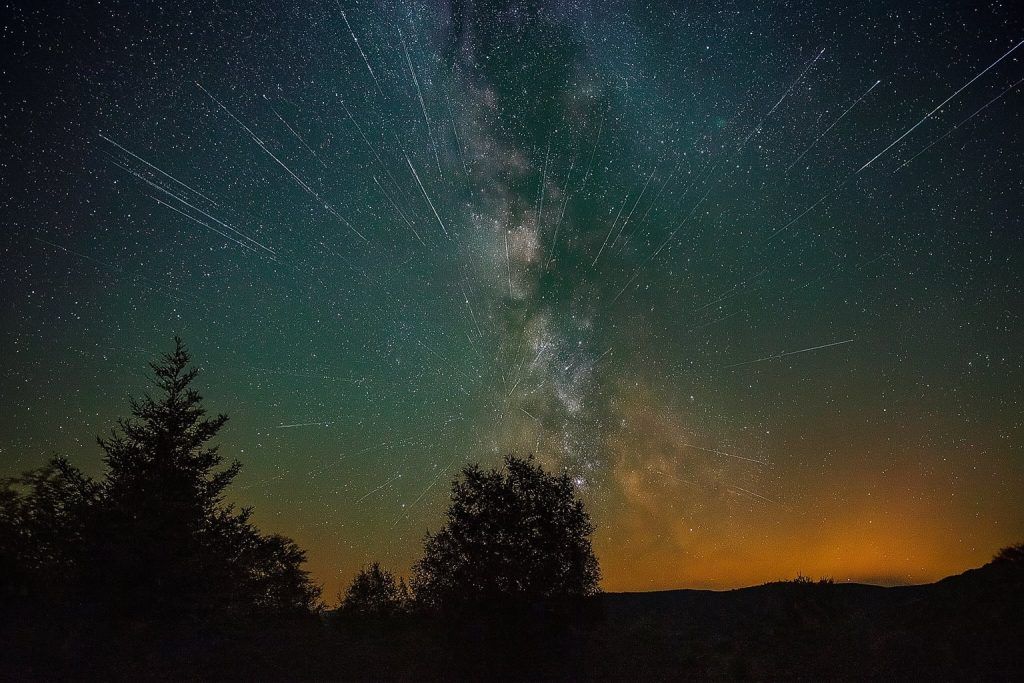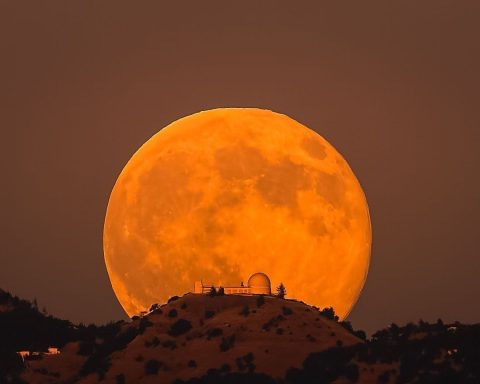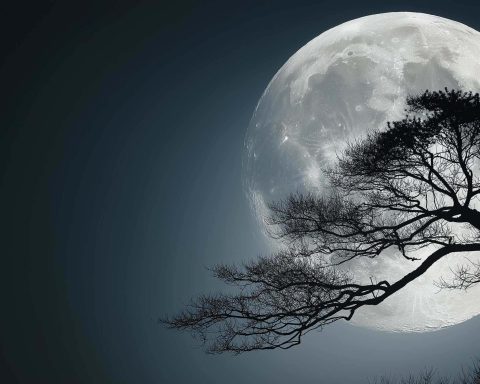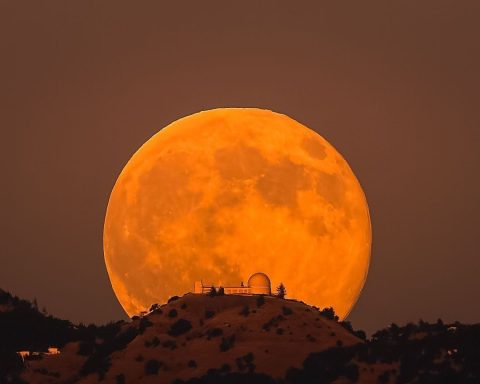- Peak illumination occurs on Saturday, August 9, 2025 at 3:55 a.m. EDT (07:55 GMT), with the Moon opposite the Sun in Capricornus near Deneb Algedi and fully illuminated toward Earth.
- The full Moon will be visible for two nights, rising near sunset on August 8 and August 9, with New York City at about 8:03 p.m. on Aug 8 and 8:32 p.m. on Aug 9.
- It is not a supermoon; the 2025 supermoons are Harvest Moon on October 7, Beaver Moon on November 5, and Cold Moon on December 4.
- On August 12 the Moon will pass within about 3.5° of Saturn and Neptune in the night sky.
- Peak Perseids meteor activity on August 12–13 will be washed out by the bright Moon, with NASA noting about 10–20 meteors per hour instead of 40–50 under dark skies.
- The astrology places the Moon in Aquarius at 17° opposite the Leo Sun, highlighting themes of connection, collaboration, and community during August 7–13.
- Uranus forms a favorable astrological pattern, exactly trining Saturn and Neptune, trining Mars, and sextiling Mercury during the full-moon window.
- Traditional names for August’s full Moon include Sturgeon Moon in North America, Salmon Moon in the Haida, Green Corn/Grain Moon, Red Moon, Wild Rice Moon (Ojibwe), and Corn Moon in China.
- August’s full Moon coincides with Raksha Bandhan on August 9, Tu B’Av beginning August 8–9, and Nikini Poya in Sri Lanka, among other observances.
- Environmental and observational effects include stronger spring tides, potential influences on wildlife behavior, and a popular but challenging target for moonrise photography and sleep patterns.
The full moon on August 9, 2025 promises a spectacular two-night celestial show with rich scientific, astrological, and cultural significance. This “Sturgeon Moon” – as it’s traditionally called – brings astronomical marvels, astrological insights, and age-old legends and festivals into focus. Here’s everything you need to know about this full moon’s timing, meaning, and worldwide impact.
Scientific & Astronomical Highlights
- Peak Illumination: The Moon officially reaches its full phase on Saturday, August 9, 2025 at 3:55 a.m. EDT (07:55 GMT) [1] [2]. That corresponds to 12:55 a.m. Pacific Time and 8:55 a.m. in London [3]. At that moment the Moon will lie opposite the Sun from Earth (in the constellation Capricornus near the star Deneb Algedi) [4], with its Earth-facing side fully illuminated.
- Visible for Two Nights: Unusually, this full moon will put on a show over two consecutive evenings. Because the peak occurs pre-dawn on Aug. 9, skywatchers can watch a nearly-full moon rise at dusk on both Aug. 8 and Aug. 9 with almost identical grandeur [5] [6]. In fact, in mid-northern latitudes, August full moons rise at a shallow angle, making the moonrise times only ~30 minutes apart on successive nights (instead of the typical ~50 minutes). This geometry creates a “two-night” full moon spectacle [7] [8] – for example, in New York City the Sturgeon Moon rises at 8:03 p.m. on Aug. 8 (just after sunset) and 8:32 p.m. on Aug. 9 [9].
- How to See It: The best time to view a full moon is at moonrise around local sunset, when the Moon looms low on the horizon. At moonrise on Aug. 8–9, the Sturgeon Moon may appear unusually large and amber-hued to the eye [10]. This is an optical trick called the “moon illusion” – the Moon looks bigger near the horizon – and the orange tint is caused by Earth’s atmosphere scattering blue light and letting more red-orange wavelengths through [11]. No special equipment is needed to enjoy the full moon, though binoculars or a small telescope can reveal craters and “seas” on its surface in more detail [12].
- Not a Supermoon: While impressive, the August 9 full moon is not technically a “supermoon” (a full moon near perigee, its closest point to Earth). The supermoons of 2025 occur later in the year – for instance the Harvest Moon on Oct. 7, Beaver Moon on Nov. 5, and Cold Moon on Dec. 4 are all supermoons [13]. August’s full moon will shine just as brightly, but without the slight size boost of a supermoon.
- Astronomical Extras: This full moon rises just a few days before other cosmic events. Three days later (Aug. 12), the waning moon will swing close to Saturn in the night sky [14]. In fact, the Moon will pass within about 3.5° of Saturn (and the fainter Neptune) on Aug. 12, making a pretty pairing – Saturn will be just to the right of the Moon for those observing that night [15]. August is also Perseid meteor shower season, but unfortunately the bright moonlight will coincide with the Perseid peak on Aug. 12–13, washing out many faint shooting stars [16]. NASA meteor expert Bill Cooke notes that under dark skies one might normally see ~50 Perseids per hour, but “you’re probably going to see 10 to 20 per hour or fewer” at peak this year “because we have a bright Moon…washing out the fainter meteors” [17] [18]. In short, only the very brightest meteors or an occasional fireball will punch through the moon’s glare [19].
Did you know? Not all astronomers welcome a full moon – its brilliance can actually drown out faint celestial objects. Many stargazers find the full moon’s glare a nuisance, preferring the darker skies of other lunar phases for observing stars and galaxies [20]. Even lunar detail can be harder to see at full phase (with no shadows to highlight craters). So, while the public enjoys the beautiful bright moon, astrophotographers and deep-sky observers often patiently wait for the Moon to wane!
Astrological Significance: An Aquarius Full Moon
In the realm of astrology, the August 9 full moon carries potent meaning. Occurring during Leo season, this full moon falls in the zodiac sign of Aquarius (at 17° Aquarius) [21] – directly opposite the Leo Sun. Astrologers view this as a time to balance fiery personal expression (Leo) with community-minded ideals (Aquarius) [22]. In practice, that means themes of connection, collaboration, and future vision come to the forefront during this lunation.
Energy and Themes: Because the full moon is in Aquarius – a progressive Air sign – its energy is thought to emphasize our social ties, friendships, and collective aspirations [23]. One astrologer notes that both Leo and Aquarius deal with how we give and receive love: Leo focuses on creative self-expression and romance, while Aquarius focuses on the community and humanity at large [24]. This duality encourages us to consider personal passions and the greater good. Many may feel inspired to gather with others, share ideas, or reflect on their role in their community under this moon’s influence.
Planetary Influences: Uniquely, this full moon comes with some auspicious planetary alignments. Uranus – the modern ruler of Aquarius – is making harmonious aspects during the full moon window. Celebrity astrologer Kyle Thomas explains that Uranus is in a “dazzling dance with many planets”, which is actually good news [25]. According to Thomas, Uranus forms an exact trine (a very favorable angle) to Saturn and Neptune, “bringing innovation, imagination, spiritual breakthroughs, and opportunities for long-term success” [26]. At the same time, Uranus trines fiery Mars, sparking “passion to reach new horizons” and encouraging us to meet new people or try new experiences [27]. Finally, Uranus is sextile Mercury, which can “stimulate visionary ideas, mental breakthroughs and a festive, social atmosphere”, Thomas says [28]. In short, astrologers predict “vibrant, expansive, and connected energy” under this full moon [29]. The advice? Embrace the opportunity for creative change and community connection. Many see full moons as a peak time to release what no longer serves you and set intentions – and with these supportive Uranian aspects, the cosmic vibe around August 9 is one of breakthroughs and fresh perspectives.
Timing: Astrologically, the moon’s influence isn’t confined to a single night. Practitioners say you may feel the effects a few days before and after the exact full moon. For this moon, that roughly spans August 7–13, 2025 [30]. It could be an excellent week to journal, meditate, or perform full-moon rituals focused on community, friendship, and innovation. (Incidentally, August 8 is the famed “Lion’s Gate” in New Age astrology, a date believed to be spiritually significant – adding more mystical energy around this full moon period.)
Cultural and Mythological Significance
Full moons have captivated human cultures for millennia, giving rise to names, myths, and rituals around the world. The August full moon in particular carries its own lore. Here’s a look at what this moon signifies in various traditions:
Traditional Names for the August Full Moon
Many cultures named each month’s full moon based on seasonal cues. “Sturgeon Moon” is the common American name for August’s full moon, originating from fishing tribes and colonial Americans noting the abundance of sturgeon fish in late summer [31]. But that’s not the only name: different peoples had their own references for this moon, often tied to nature’s calendar.
- Sturgeon Moon (North America): Refers to the large sturgeon fish which were traditionally easiest to catch in the Great Lakes and rivers during August [32]. The name likely emerged from both Native American and settler lore in the northeastern U.S. where sturgeon were important [33]. (By contrast, on the Pacific Northwest coast, the Haida called the August moon the “Salmon Moon,” reflecting the salmon runs more vital to their culture [34].)
- Green Corn Moon / Grain Moon: In some Anglo-European and American farming traditions, August’s full moon was called the Green Corn Moon or Grain Moon, signaling that crops like corn and grains were ripening for harvest [35]. It’s a nod to the agricultural calendar – late summer is the time of mature green corn and the gathering of grains.
- Red Moon: An old nickname “Red Moon” alludes to the reddish hue the moon often takes on in the summer haze, especially when rising or during humid August nights [36].
- Wild Rice Moon (Anishinaabe): According to the Anishinaabeg (Ojibwe) people, this was the Wild Rice Moon, indicating the time to harvest wild rice in late summer [37]. Different Native American nations had distinct lunar calendars; for the Ojibwe, manoomin (wild rice) was a key late-summer food, hence the moon’s name.
- Corn Moon (China and elsewhere): Interestingly, many of these traditional names find echoes globally. NASA notes that beyond North America, “Green Corn Moon” or “Grain Moon” have been recorded as alternate names for this moon [38]. (In Chinese farming culture, a full moon around late summer might be associated with grain harvests as well, though the more famous Chinese Moon festival is a month later in autumn.)
These diverse names paint a picture of how important the full moon was for marking time and seasonal change. Communities tracked the lunar cycle to know when to fish, plant, or harvest – a practice that underlies many full moon names.
Festivals and Observances on the August Full Moon
August’s full moon also aligns with several cultural and religious events each year. Different faiths and communities hold festivals or ceremonies on the full moon day (or month) of August:
- Raksha Bandhan (Hindu tradition): In 2025, August 9 coincides exactly with Raksha Bandhan, a popular Hindu festival celebrated on the full moon of the month of Shravana. On this day, sisters tie rakhi (sacred threads) on their brothers’ wrists as a symbol of love and protection, and families come together to honor the sibling bond [39]. All across India (and in Hindu communities worldwide), millions partake in this ritual. It’s a public holiday in some regions, with sweets, gifts, and blessings exchanged under the bright Shravan Purnima moon.
- Tu B’Av (Jewish “Day of Love”): The full moon of mid-late summer corresponds to Tu B’Av in the Hebrew calendar – a minor Jewish holiday often compared to a “Jewish Valentine’s Day.” In 2025, Tu B’Av begins at sundown August 8 and continues through August 9 (the 15th of the month of Av) [40]. Tradition holds that in ancient times this was a joyous day of dancing and matchmaking. Today it’s considered an auspicious date for weddings and romantic celebrations. The 15th of Av is regarded as a festive day of love, and modern Israelis and Jewish communities worldwide mark it with romantic dinners, parties, and sometimes communal events. As one source notes, Tu B’Av on this full moon is “considered auspicious for weddings” and new beginnings in love [41].
- Nikini Poya (Buddhist – Sri Lanka): In Buddhist Sri Lanka, every full moon is a public holiday called a Poya day dedicated to religious observances. The August full moon is known as Nikini Poya, which has special significance. It commemorates events like the First Buddhist Council (held shortly after the Buddha’s passing, over 2,500 years ago) and marks the continuation of the sacred “Vassa” retreat period for monks [42]. Devotees flock to temples on Nikini Poya to meditate, chant sutras, and observe sil (Eight Precepts). It’s considered a time of reflection and spiritual renewal. (In Thailand and other Theravada Buddhist countries, similar full-moon observances occur during the rainy season retreat.) These practices highlight how the full moon is woven into the fabric of Buddhist ritual life.
- Hungry Ghost Festival (Chinese culture): In Chinese tradition, the 7th lunar month is Ghost Month, and the Full Moon of that month is known as the Hungry Ghost Festival (Zhongyuan Jie). In 2025, due to a lunar leap month, the Ghost Festival falls later (September 6, 2025) [43] [44], so it does not coincide with the August 9 full moon (which is actually in the 6th leap month). However, it’s worth noting as an example of cultural full-moon observance: during Ghost Festival, people prepare offerings and observe rituals to appease restless spirits under the full moon’s light. While not directly on Aug. 9 in 2025, it shows the importance of full moons in the Chinese lunar calendar for timing festivals.
- Modern Pagans and Full Moon Rituals: Around the world, many modern Pagans, Wiccans, and New Age spiritual groups hold gatherings on the full moon known as Esbats. During an Esbat, participants might perform lunar rituals, meditate, or work magic, believing the full moon’s energy is at its peak. They honor the moon goddess (in her many forms, from the Roman Luna to the triple goddess of Wicca) and often charge crystals or perform healing spells under the moonlight [45] [46]. The August full moon would be no exception – one can expect moon circles, drumming gatherings, and meditation meetups in various communities, all bathing in the Sturgeon Moon’s glow.
- Myth and Folklore: Culturally, the full moon has long been associated with mythical phenomena. The term “lunacy” stems from Luna, the Roman moon goddess, reflecting old beliefs that a full moon could induce madness. Folklore in Europe spoke of werewolves shapeshifting under the full moon, and even today some people half-jokingly blame odd human behavior on the full moon. While science finds no proof of increased ER visits or crime on full moons, these myths persist as part of lunar lore. Many will recall that a “blue moon” (two full moons in one month) is considered rare and unlucky by some, and auspicious by others. Although August 2025 has only one full moon, the aura of the full moon night will nonetheless be steeped in such legendary atmosphere – it’s hard not to feel a bit of magic when you see that bright disk rising!
- Global Gatherings: In secular culture, full moons inspire communal events too. One famous example is the Full Moon Party in Koh Phangan, Thailand, an all-night beach festival that draws thousands of travelers each month under the full moon [47]. Coinciding with the lunar calendar, the party for August 2025 is set for Saturday, Aug. 9, 2025 [48] – perfectly timed with the Sturgeon Moon. Revelers painted in neon dance until dawn on Haad Rin Beach, literally partying by the light of the moon. It’s a modern testament to how the full moon continues to bring people together in celebration (albeit with DJs and cocktails rather than ancient rites!). Around the world, you might also find full-moon hiking tours, moongazing picnics, and astronomy night events hosted by local observatories on this date, inviting the public to enjoy and learn about the Moon.
In essence, the August full moon serves as a common thread uniting diverse cultures and faiths – from religious fasting or feasting, to familial ceremonies, to communal revelry. It’s a night where many, in very different ways, look up and celebrate the Moon.
Environmental and Natural World Impacts
Beyond human culture, a full moon also subtly affects the natural world. Here are a few ways the Moon’s fullness touches Earth’s environment and creatures:
- Tides: Full moons (and new moons) bring the strongest tides of the lunar cycle, known as spring tides. Around August 9, the alignment of Sun, Moon, and Earth will produce especially high high-tides and low low-tides in the days immediately following the full moon. Fishermen, sailors, and coastal dwellers often pay attention to the full moon tide tables. (Fortunately, August 9 is not a supermoon, so while tides will be robust, they won’t be extreme – the perigee full moons later in the year will have an even greater tidal pull [49].) Still, beach-goers might notice the ocean creeping a bit further up the shore during the full Sturgeon Moon.
- Planting & Harvesting: Folklore holds that the Moon influences plant growth. According to the Farmers’ Almanac, many gardeners swear seeds and plants respond to lunar phases. The theory is that seeds absorb the most water during full moons (and new moons), when tidal forces are highest, which can aid germination [50]. While scientific evidence is mixed, traditional “planting by the moon” calendars advise sowing certain crops in the waxing moon and harvesting in the waning phase. In fact, late summer crops like beans or second plantings of root veggies are often timed with the August moon. And the term “Harvest Moon” (usually the September full moon) reflects how farmers historically relied on full moonlight to extend their harvest work into the night. So this Sturgeon Moon continues that legacy – providing a little extra evening light for farmers and gardeners bringing in late summer produce.
- Wildlife Behavior: Nocturnal animals are tuned to the lunar cycle. A full moon means brighter nights, which can change how animals behave. Prey species like rodents might hide more (to avoid being spotted under the moonlight), whereas predators such as owls and coyotes could take advantage of the illumination to hunt. Some studies have noted lions tend to have less hunting success on full moon nights due to the brightness, and certain birds sing more at night during full moons. In the oceans, coral reef spawning events are often linked to full moons at specific times of year (though August isn’t a major spawning month in most reefs). And notably, the sturgeon fish that give this moon its name were likely caught in greater numbers during full moon periods historically – perhaps because fishermen could see better at night or because the fish themselves behaved differently. In modern times, anglers still note that moon phase can affect fish biting patterns. Expect to hear some fishermen trying their luck on the nights around August 9, claiming the fish bite best under a bright moon!
- Human Sleep and Mood: It’s not just folklore – a full moon might subtly affect human sleep. Some research has suggested people get slightly less deep sleep and go to bed later in the days around a full moon (possibly due to the extra light or our circadian rhythms). While the effect is small, you might blame the Sturgeon Moon if you find yourself a bit more restless on August 9! On the flip side, many people report feeling energized or inspired by the full moon. The beautiful sight of a huge moon can certainly lift one’s mood. It’s common to see a spike in social media activity – photos of the moon, poetic musings – as everyone collectively marvels at the lunar light.
In short, the full moon is a reminder of nature’s rhythms. It tugs on our oceans, it marks time for ancient ecosystems, and it even tugs at our imaginations. The August full moon may not cause dramatic physical changes, but it quietly syncs with the ebb and flow of life on Earth.
In the News: August 2025 Full Moon Buzz
This particular full moon has drawn attention in both scientific and popular media:
- “Two-Night Sturgeon Moon” Headlines: Astronomy writers are excited that 2025’s August full moon offers a double feature. LiveScience dubbed it a “special 2-night affair,” noting skywatchers can enjoy nearly full moonrise two evenings in a row (Saturday and Sunday) [51]. This rare treat is getting press, with experts explaining the orbital quirk that allows the Moon to appear full on back-to-back nights in August [52]. So, if you see articles or social media posts urging you not to miss the full moon both Friday and Saturday night, it’s not a mistake!
- NASA’s Viewing Advisory: NASA has also chimed in, mainly in context of the Perseid meteors. In a blog update, NASA highlighted that the waning gibbous Moon after August 9 will hinder Perseid meteor viewing during the shower’s peak [53] [54]. They even quantified it: the average person might see only 10–20 meteors/hour instead of 40–50 because of the “bright Moon in the sky washing out the fainter meteors” [55]. This quote from Bill Cooke, lead of NASA’s Meteoroid Environment Office, has been circulating in news articles as a caution to meteor hunters. It’s a good reminder that while the full moon is lovely, it can outshine other celestial fireworks.
- Expert Quotes: Astronomers and planetarium educators have been explaining the Sturgeon Moon to the public. Many note that the Sturgeon Moon’s name is a chance to discuss ecology and history – for instance, how Lake sturgeon populations were once plentiful and are now protected. Some have been quoted encouraging people to simply go outside and look, emphasizing that the Moon is one celestial object everyone can enjoy without a telescope. Meanwhile, astrologers have been busy sharing horoscopes for the full moon. People Magazine featured astrologer Kyle Thomas’ take, even calling this full moon “fiery” and hinting at romantic breakthroughs for some signs [56] [57]. Such pieces add to the buzz, ensuring that both the scientifically curious and the mystically inclined have something to latch onto.
- Social and Cultural Media: Expect to see plenty of stunning moon photos on the nights of Aug 8–9, as photographers and amateurs alike post images of the golden moon low over city skylines and landscapes. Planetariums and science centers have likely scheduled full-moon hikes or telescope nights (weather permitting) and are posting “know before you go” guides (like reminding folks the Moon will rise in the east/southeast around sunset locally). Culturally, news outlets in India will cover Raksha Bandhan celebrations on Aug 9 – you might catch colorful images of sisters tying rakhis in the morning, all timed by the auspicious full moon. Israeli and Jewish news may mention Tu B’Av events happening that weekend. And travel blogs or TikTok videos might pop up from the Thailand Full Moon Party on Aug 9, showcasing that unique way of honoring the moon (by dancing under it!). All told, the Sturgeon Moon is making waves in news and social media, proving that our nearest celestial neighbor still captivates the public eye.
Bottom line: The Full Moon of August 9, 2025 is far more than just a lunar phase on the calendar. It’s an astronomical event – lighting up summer nights and aligning with other cosmic happenings. It’s an astrological moment – stirring themes of community and innovation. It’s a cultural mirror, reflecting traditions from fishing lore to religious festivals to beach parties. And above all, it’s an opportunity for everyone to step outside, look up, and share a moment of wonder. So mark your calendars, and under the glow of the Sturgeon Moon, take a moment to appreciate the science, the stories, and the shared human heritage tied to that bright orb in the sky. Clear skies!
Sources:
- Space.com – “August full moon 2025 rises this weekend: … ‘Sturgeon Moon’” [58] [59] [60]
- Space.com – “Full Sturgeon Moon arrives ahead of close planetary pass” [61] [62] [63]
- LiveScience – Jamie Carter, “Sturgeon Moon 2025: What makes August’s full moon special 2-night affair” [64] [65] [66]
- BBC Sky at Night – “Full Moon 2025 calendar dates” [67] [68]
- Old Farmer’s Almanac / Farmers’ Almanac – Full Moon August 2025 info & astrology [69] [70]
- People Magazine – Skyler Caruso, “August’s Full Moon…Romantic Breakthroughs” (Astrology with Kyle Thomas) [71] [72]
- Space.com – “What to see during all 4 major moon phases (Aug 2025)” [73]
- NASA – J. Barnett, “Bright Moonlight Could Interfere with Perseids’ Peak” [74] [75]
- Space.com – “August’s Sturgeon Moon leaps above the horizon at sunset” [76] [77]
- Space.com – “Full moon known as green corn moon, grain moon, red moon” [78]
- Space.com – “Moon will appear full for a night or two either side of peak” [79]
- Space.com – “Deneb Algedi in constellation Capricornus at full moon” [80]
- Space.com – “Perseid meteor shower peak Aug.12–13, moon’s light challenge” [81]
- FarmersAlmanac – “Gardening by the Moon” (theory of moon phase and germination) [82]
- SereneColombo.org – “Importance of Nikini Poya (Aug Full Moon)” [83]
- Hebcal / 18Doors – Tu B’Av 2025 dates [84] (Jewish calendar)
- SunsetHillResort (Koh Phangan) – “Full Moon Party dates 2025” [85] [86]
- Space.com – “Sturgeon Moon known as Salmon Moon (Haida)” [87]
- Space.com – “August full moon marks Raksha Bandhan festival” [88]
- Space.com – “15th of Av (Tu B’Av) falls on this full moon, weddings auspicious” [89]
References
1. www.space.com, 2. www.space.com, 3. www.space.com, 4. www.space.com, 5. www.livescience.com, 6. www.livescience.com, 7. www.livescience.com, 8. www.livescience.com, 9. www.livescience.com, 10. www.space.com, 11. www.space.com, 12. www.livescience.com, 13. www.skyatnightmagazine.com, 14. www.space.com, 15. www.space.com, 16. www.space.com, 17. www.nasa.gov, 18. www.nasa.gov, 19. www.space.com, 20. www.skyatnightmagazine.com, 21. www.farmersalmanac.com, 22. www.farmersalmanac.com, 23. people.com, 24. www.farmersalmanac.com, 25. people.com, 26. people.com, 27. people.com, 28. people.com, 29. www.farmersalmanac.com, 30. www.farmersalmanac.com, 31. www.space.com, 32. www.space.com, 33. www.space.com, 34. www.space.com, 35. www.space.com, 36. www.space.com, 37. www.livescience.com, 38. www.livescience.com, 39. www.space.com, 40. www.hebcal.com, 41. www.space.com, 42. www.serenecolombo.org, 43. en.wikipedia.org, 44. www.easytourchina.com, 45. wiccaliving.com, 46. trinitarianwicca.com, 47. www.sunsethillresort.com, 48. www.sunsethillresort.com, 49. www.skyatnightmagazine.com, 50. www.farmersalmanac.com, 51. www.livescience.com, 52. www.livescience.com, 53. www.nasa.gov, 54. www.nasa.gov, 55. www.nasa.gov, 56. people.com, 57. people.com, 58. www.space.com, 59. www.space.com, 60. www.space.com, 61. www.space.com, 62. www.space.com, 63. www.space.com, 64. www.livescience.com, 65. www.livescience.com, 66. www.livescience.com, 67. www.skyatnightmagazine.com, 68. www.skyatnightmagazine.com, 69. www.farmersalmanac.com, 70. www.farmersalmanac.com, 71. people.com, 72. people.com, 73. www.space.com, 74. www.nasa.gov, 75. www.nasa.gov, 76. www.space.com, 77. www.space.com, 78. www.space.com, 79. www.space.com, 80. www.space.com, 81. www.space.com, 82. www.farmersalmanac.com, 83. www.serenecolombo.org, 84. www.hebcal.com, 85. www.sunsethillresort.com, 86. www.sunsethillresort.com, 87. www.space.com, 88. www.space.com, 89. www.space.com










